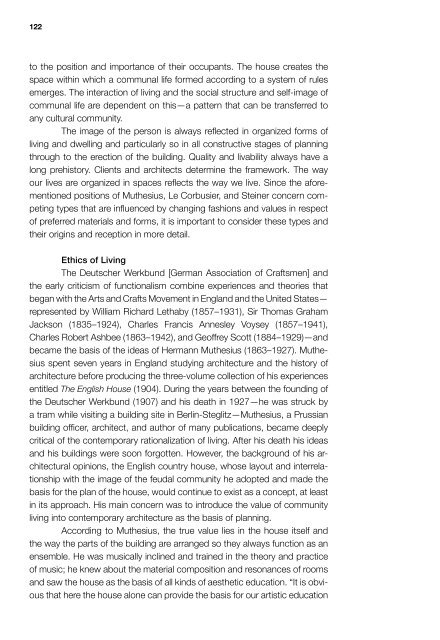Neuroarchitecture
978-3-86859-479-9 https://www.jovis.de/de/buecher/product/neuroarchitecture.html
978-3-86859-479-9
https://www.jovis.de/de/buecher/product/neuroarchitecture.html
Create successful ePaper yourself
Turn your PDF publications into a flip-book with our unique Google optimized e-Paper software.
122<br />
to the position and importance of their occupants. The house creates the<br />
space within which a communal life formed according to a system of rules<br />
emerges. The interaction of living and the social structure and self-image of<br />
communal life are dependent on this—a pattern that can be transferred to<br />
any cultural community.<br />
The image of the person is always reflected in organized forms of<br />
living and dwelling and particularly so in all constructive stages of planning<br />
through to the erection of the building. Quality and livability always have a<br />
long prehistory. Clients and architects determine the framework. The way<br />
our lives are organized in spaces reflects the way we live. Since the aforementioned<br />
positions of Muthesius, Le Corbusier, and Steiner concern competing<br />
types that are influenced by changing fashions and values in respect<br />
of preferred materials and forms, it is important to consider these types and<br />
their origins and reception in more detail.<br />
Ethics of Living<br />
The Deutscher Werkbund [German Association of Craftsmen] and<br />
the early criticism of functionalism combine experiences and theories that<br />
began with the Arts and Crafts Movement in England and the United States—<br />
represented by William Richard Lethaby (1857–1931), Sir Thomas Graham<br />
Jackson (1835–1924), Charles Francis Annesley Voysey (1857–1941),<br />
Charles Robert Ashbee (1863–1942), and Geoffrey Scott (1884–1929)—and<br />
became the basis of the ideas of Hermann Muthesius (1863–1927). Muthesius<br />
spent seven years in England studying architecture and the history of<br />
architecture before producing the three-volume collection of his experiences<br />
entitled The English House (1904). During the years between the founding of<br />
the Deutscher Werkbund (1907) and his death in 1927—he was struck by<br />
a tram while visiting a building site in Berlin-Steglitz—Muthesius, a Prussian<br />
building officer, architect, and author of many publications, became deeply<br />
critical of the contemporary rationalization of living. After his death his ideas<br />
and his buildings were soon forgotten. However, the background of his architectural<br />
opinions, the English country house, whose layout and interrelationship<br />
with the image of the feudal community he adopted and made the<br />
basis for the plan of the house, would continue to exist as a concept, at least<br />
in its approach. His main concern was to introduce the value of community<br />
living into contemporary architecture as the basis of planning.<br />
According to Muthesius, the true value lies in the house itself and<br />
the way the parts of the building are arranged so they always function as an<br />
ensemble. He was musically inclined and trained in the theory and practice<br />
of music; he knew about the material composition and resonances of rooms<br />
and saw the house as the basis of all kinds of aesthetic education. “It is obvious<br />
that here the house alone can provide the basis for our artistic education


















